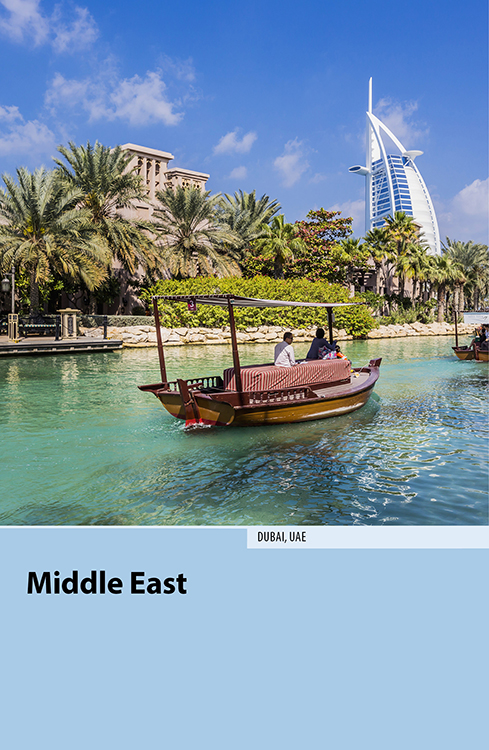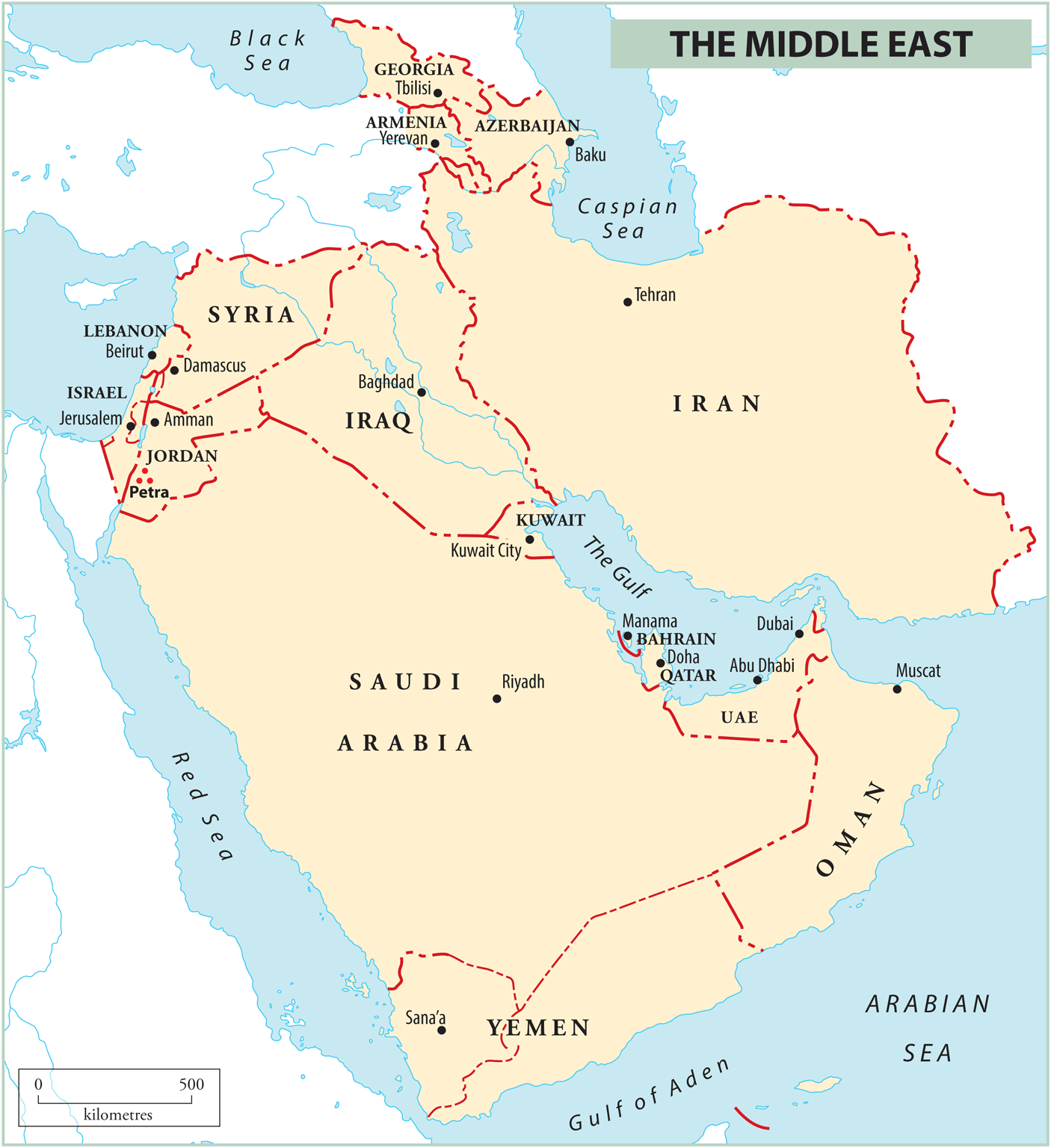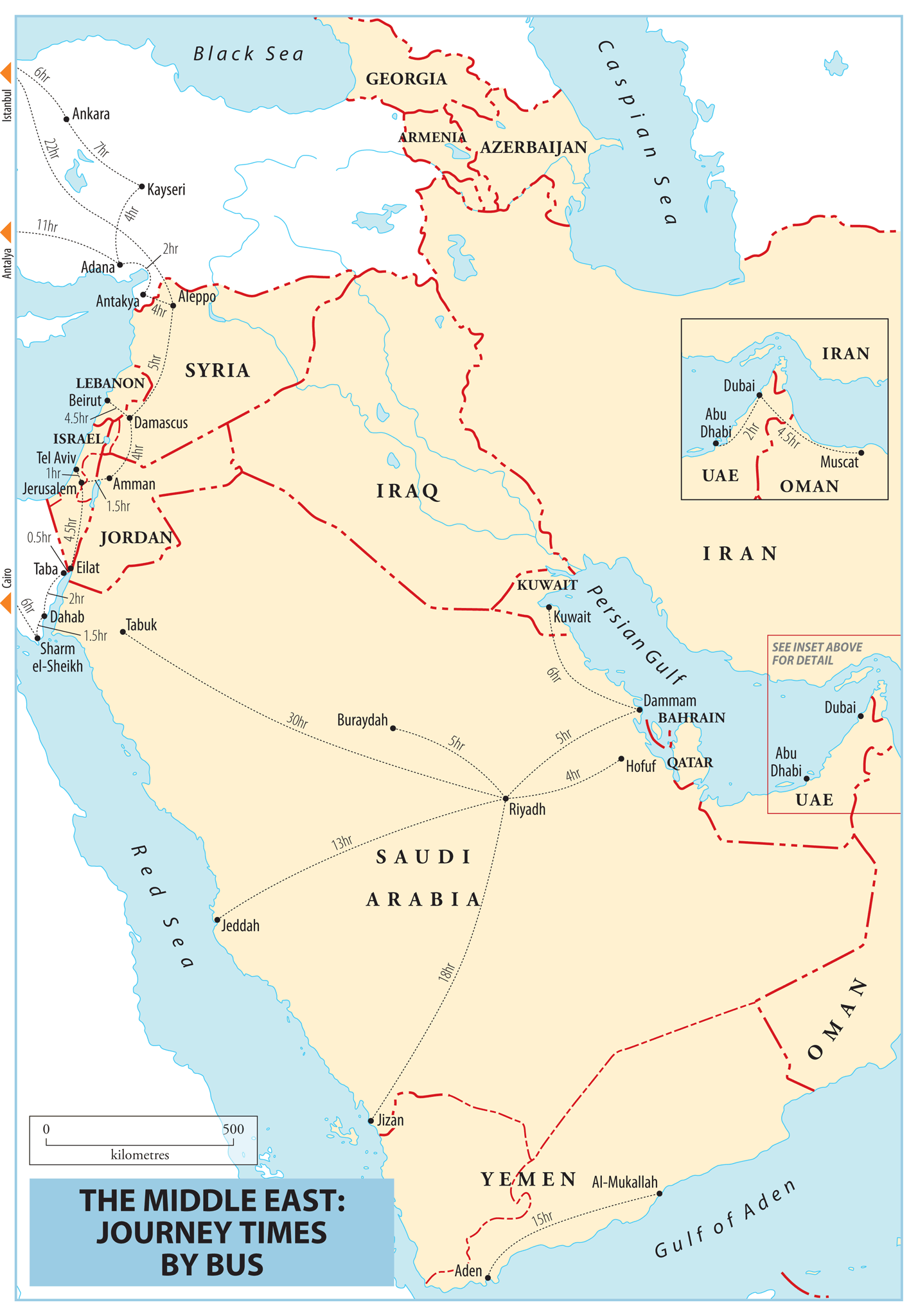
Let’s cut right to the chase: is the Middle East safe? Depends on where you’re going. From a travel perspective, the aftermath of the Arab Spring has caused a great deal of instability. Violence and protests can occur, but the fact that there are so many news bureaus covering such a small plot of land means that news of violence ricochets around the world. Often the countries are far safer than the media would have you believe, so it’s good to check out the most recent political situation. When the region is plagued with headline-grabbing incidents that don’t threaten general stability, the good news is that there’s a chance you’ll be visiting some of the world’s greatest archeological sites in relative solitude. You’ll also be able to enjoy the calming effect of walking barefoot over the hand-woven carpets of a mosque, tasting fresh-squeezed fruit juices, experiencing the hospitality and hummus of the Jordanians, and taking a desert safari in the United Arab Emirates.

MAIN ATTRACTIONS
1 Burj Khalifa United Arab Emirates. At 829.8m (2722ft), this Dubai skyscraper is currently the world’s tallest building, and a not-so-subtle symbol of Dubai’s rapid rise. Created by architect Adrian Smith and engineer Bill Baker, it opened in 2010 and has an observation deck on the 148th floor; from that high even Dubai’s other iconic building, the “seven-star” Burj al Arab, seems insignificant. Book tickets well in advance to take advantage of the “cheap” $35 standard tickets so you can skip the wait, or fork out $80 for fast-track tickets.
2 Jerusalem Israel. If you can see past the skirmishes that continue to mar this city, you’ll find an architectural beauty forged from thousands of years of chaos. There’s the Dome of the Rock, where Mohammed is believed to have ascended to heaven; the Church of the Holy Sepulchre, where Christ is believed to have been crucified; and the Western (or Wailing) Wall, the closest piece of Israeli real estate to the ancient site of the Second Temple (where the Dome of the Rock now stands). As a traveller you’re free to roam (after passing through metal detectors) to all three sites and pick up falafels, fresh dates and pistachio nuts along the way.
3 Petra Jordan. This ancient Nabatean city, built into the rose-coloured canyon walls in the Jordanian desert, had been lost to the outside world for over 1000 years when it was rediscovered in 1812 by Johann Burckhardt. The ruins are approached on foot via the Siq, a 1.2-kilometre canyon not much wider than a queen-sized mattress. Nearby is Wadi Rum, also known as the Valley of the Moon, as entering this desert landscape with towering granite and sandstone formations makes you feel like you’ve left planet Earth.
4 Red Sea diving and snorkelling Israel and Jordan. One moment you’re on the edge of a bleak desert, getting blasted by convection-oven-like winds. The next you’re in an aquamarine paradise surrounded by schools of multihued fish. You pop your head up again to be sure the desert is still there. It is. The stark contrast simply adds to the experience of diving one of the world’s great reefs.
SECURITY ISSUES
It’s always a good idea to check the current political conditions before visiting a country (see Chapter 15), but the following are worth a little extra research: Armenia, Georgia, Iran, Iraq, Israel/Palestine, Lebanon, Saudi Arabia, Syria (no-go at the time of writing), Yemen.
WHEN TO GO
Winter is the most likely obstacle you’ll face, and that’s only if you’re trying to avoid the snow, which has been known to make many of the higher roads impassable. You might also want to try to sidestep the hot summer months if you’re doing more than diving the Red Sea and swimming in the Med. Throughout the region, spring and autumn (April, May, Sept and Oct) are the optimum times to visit.
RECOMMENDED VACCINATIONS
- Routine boosters for measles/mumps/rubella (MMR), diphtheria/pertussis/tetanus (DPT) and polio
- Hepatitis A
- Hepatitis B (optional)
- Rabies (optional)
- Typhoid
- Meningitis (only for Hajj pilgrims)
- Yellow fever (entry requirement in serveral countries if arriving from a risk area)
GETTING AROUND BY AIR
Flying is the most reliable and speedy way to get around the Middle East, but it’s also the most expensive. If your kidneys are tired from the long bus rides, you might try one longer hop, but without air passes available it’s a quick way to drain your finances. There are no flights available to Iraq, or between Israel and nearby countries, with the exceptions of Jordan and Egypt.
LOWEST DAILY BUDGET
Expensive (£40–60/$62–94):
Oman, Kuwait, United Arab Emirates
Mid-range (£20–35/$31–55):
Bahrain, Israel, Lebanon, Qatar, Saudi Arabia
Budget (£12–20/$19–31):
Iran, Jordan, Syria, Yemen
OVERLAND ROUTES
There’s really just one classic overland route. It goes from Istanbul to Cairo, via Syria (which is, at time of writing, not advisable), Jordan, Israel and the Sinai Peninsula. Doing it in reverse makes things difficult if you allow the Israelis to stamp your passport, although they’ll put it on a separate piece of paper if you ask. You could also pop over to Lebanon on the way, but the Lebanon–Israel border is still a little dodgy for crossings. Probably the best way to get around is on buses and trains, with hired taxis for harder-to-reach places outside of popular bus routes.
SAMPLE RETURN AIRFARES
Amman to:
- Cairo £180/$280
- Muscat £220/$345
Dubai to:
- Amman £90/$140
- Riyadh £170/$265
Tel Aviv to:
- Amman £320/$500
- Istanbul £90/$140
BUSES
Outside of the rich, Sport Utility Vehicle-driving Gulf states, the bus is the most common mode of transport in the Middle East for locals and travellers alike. There are no bus package-deals for the region, but bus travel is so cheap that this isn’t a problem. On some Arab buses, they like to collect passengers’ ID cards. Hand over your least valuable photo ID. An old driving licence or ISIC card usually works fine. Some taxis function as buses as well. These shared taxis move a little more quickly, don’t stop as long and cost a bit more. They don’t have fixed times but run frequently on regular routes, and can often be flagged down from the side of the road if there’s space available. (They usually leave from a regular departure spot when full, and places become available as they drop people off along the way.)

TRAINS
Trains are typically cheaper than buses, but they’re also slower, less
prevalent and less frequent. One train runs weekly between Ankara and
Aleppo (25hr), and the Hejaz Jordan railway between Damascus and Amman
(11hr), though note that these services are subject to the development
of the Syrian Civil War; visit ![]() seat61.com to see if they’re operational when you want to
go.
seat61.com to see if they’re operational when you want to
go.
CARS
For more flexible travel, a long-term taxi or rental car is going to be the best option. Importing a car is unlikely to be worth the effort and expense, unless you plan to continue your trip across Africa or on to Australia.
BIKES
Bicycle touring is uncommon in the Middle East, but far from impossible. The summer heat from June to August can (literally) melt you into the pavement. Keep a pair of lightweight trousers out and available to quickly slip on when you stop, as shorts are not likely to be a hit with the locals.
BOATS
There are a number of boats that can bridge your overland travels in the region, including a three-hour ride between Aqaba and Nuweiba in the Sinai (1hr for high-speed), and an infrequent three-day ferry between Jeddah and Suez. Divers and others can catch a ferry (1hr 30min) from Sharm-el-Sheikh to Hurghada. There is also a ferry (3hr) from Hurghada or Safaga to Duba on the Saudi side, and the Duba-Suez route has recently restarted.
HITCHING
Hitching, defined as getting a lift for free, doesn’t really exist in the Middle East outside of Israel. You’ll see many people standing along the road looking for a ride, but they’re either waiting for a bus or a shared taxi or someone who will give them a ride for the price of a bus or shared taxi. In other words, you can hitch (no thumbing, just extend your arm palm down) but offer to pay for the ride. In Israel, hitching is common but not recommended, except for soldiers who hitch in uniform with their guns slung over their backs, and get rides immediately. Because of the tensions in the area, Israelis are particularly wary of picking up non-soldiers, so you might, if you’re male, try to befriend a soldier or two waiting for a ride and see if they’ll ask the driver on your behalf for a ride. With an armed soldier in the car, they usually feel better about offering a lift.
READING LIST
- Larry Collins and Dominique Lapierre O Jerusalem!
- William Dalrymple The Holy Mountain
- Nawal El-Saadawi The Hidden Face of Eve: Women in the Arab World
- Thomas Friedman From Beirut to Jerusalem
- Tony Horwitz Baghdad without a Map
- T.E. Lawrence The Seven Pillars of Wisdom
- Naguib Mahfouz Arabian Nights and Days
- Peter Mansfield The Arabs
- Edward Said Orientalism
- Paul Theroux Pillars of Hercules
VISAS
For the Middle Eastern countries that require visas, it’s not a bad idea to try to obtain them before leaving. Some visas are easier to get from home and some are easier to get on the road while in neighbouring countries. But even if you’re turned down in your home country, there’s nothing preventing you from trying again once you are in the area. Some visas may require a letter of recommendation from your embassy, which will have a standard letter for this purpose, but some embassies have been known to charge a small fee for issuing it.
VISA AND VACCINATION REQUIREMENTS FOR THE MIDDLE EAST
Armenia Visa required for Canadians, Australians and New Zealanders. Proof of onward travel and sufficient funds needed. EU and US passport holders can stay visa-free for up to 180 days in a year.
Azerbaijan Visa required for stays of up to 90 days. Invitation from individual or company in the country required.
Bahrain Visa required. Can be obtained online or on arrival, and normally good for stays of up to two weeks. Visits must be sponsored by a company, hotel, etc.
Georgia No visa required for stays of up to one year.
Iran Visa (14–30 days) required prior to arrival, with extensions
possible. US citizens apply via Pakistani Embassy in Washington, DC
(![]() daftar.org/eng).
Documentation of itinerary, confirmed hotel reservation and
sufficient funds necessary, and passport must be valid for six
months after trip. Visa will be refused if your passport has an
Israeli stamp. Western Europeans, Australians and New Zealanders can
get a 15-day tourist visa on arrival at certain airports. No visas
are required for visiting Kish from Dubai.
daftar.org/eng).
Documentation of itinerary, confirmed hotel reservation and
sufficient funds necessary, and passport must be valid for six
months after trip. Visa will be refused if your passport has an
Israeli stamp. Western Europeans, Australians and New Zealanders can
get a 15-day tourist visa on arrival at certain airports. No visas
are required for visiting Kish from Dubai.
Iraq Visa required. Available on arrival for pre-approved travellers with an Entry Visa Approval Memorandum. Passport must have six months’ validity left from date of visa application. Polio vaccination required.
Israel No visa required for stays of up to 90 days. Entry fee may apply (in Europe only for Bosnia-Herzegovina and Belarus, and no fee for US, UK, Canada, Australia and New Zealand). Can apply for additional extension (90 days). Proof of onward travel and hotel reservation required. If you’re travelling on to Arab countries, get the Israeli stamp on a separate piece of paper or you may not be allowed in.
Jordan Visa required (maximum stay 30, 90 or 180 days); can be obtained on the spot at the border or airport, and extended for up to three months. Departure tax at all airports.
Kuwait Tourist visa available at airport on arrival for stays of up to 30 days. Arriving by other means requires a visa in advance. Not having an Israeli stamp in your passport eases handling.
Lebanon Visa required (up to one month), available at airport on arrival. Visa refused with Israeli stamp in passport.
Oman Visa required (10 or 30 days). Online application at ![]() rop.gov.om. Proof of
adequate funds and onward travel is strongly recommended.
rop.gov.om. Proof of
adequate funds and onward travel is strongly recommended.
Palestinian Territories Visa required for stays of up to three months. Access is controlled by the Israeli Defence Forces.
Qatar Visa on arrival at Doha International Airport, good for 30 days in the country, for citizens of US, Canada, Australia, New Zealand, Japan and Europe (except the Czech Republic, the Baltic states and the Balkans).
Saudi Arabia Visa required; get a visa application form at ![]() saudiembassy.net.
Note that women travelling alone must be met by a male sponsor on
arrival. Proof of onward travel required. Meningitis, influenza and
polio vaccinations required for Umra and Hajj pilgrims.
saudiembassy.net.
Note that women travelling alone must be met by a male sponsor on
arrival. Proof of onward travel required. Meningitis, influenza and
polio vaccinations required for Umra and Hajj pilgrims.
Syria Visa situation unclear due to ongoing conflict. Check at your local Syrian embassy. Polio vaccination may be required.
United Arab Emirates Free visitor visa on arrival for stays up to 30 days. Longer stays require visa processing before arrival.
Yemen Tourist visa required (valid for stays of 30 days). Must be obtained before arrival in Yemen. Visitors must register with police or Passport and Immigration Authority within two weeks of arrival.